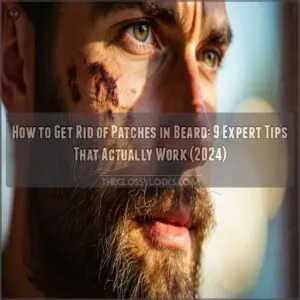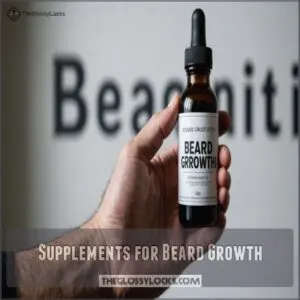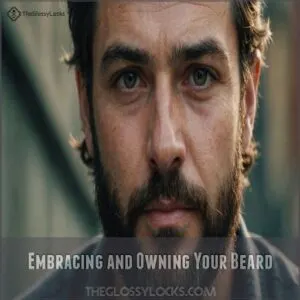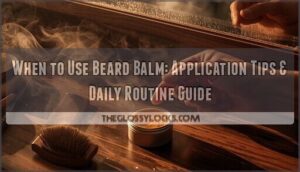This site is supported by our readers. We may earn a commission, at no cost to you, if you purchase through links.

Next, focus on nutrition – load up on biotin-rich foods like eggs and nuts. Gently brush your beard daily to stimulate follicles and distribute oils.
Consider supplements like minoxidil or try microneedling to boost growth.
Don’t forget to style smartly – the right trim can work wonders for hiding patchy areas. Remember, even Jason Momoa had to start somewhere! Stick around for more beard-boosting secrets that’ll have you rocking a fuller, more confident look in no time.
Table Of Contents
- Key Takeaways
- Causes of Patchy Beards
- Allow Your Beard to Grow
- Dietary Changes for Beard Growth
- Supplements for Beard Growth
- Microneedling and Peppermint Oil
- Grooming and Styling for a Fuller Beard
- Exercise and Stress Management
- Advanced Solutions for Patchy Beards
- Embracing and Owning Your Beard
- Frequently Asked Questions (FAQs)
- Can you fix a patchy beard?
- Does castor oil help with the growth of a beard?
- How do you treat a bald patch in a beard?
- Can beard patches fill in?
- Can you fix a patchy beard?
- Why do I have patches in my beard?
- How do I get rid of spots on my beard?
- How to get rid of bald patches in beard?
- Can hormonal treatments improve patchy beard growth?
- Are there specific beard styles for different face shapes?
- How do climate and weather affect beard patchiness?
- Can certain medications cause or worsen patchy beards?
- Are there ethnic differences in beard growth patterns?
- Conclusion
Key Takeaways
- Let your beard grow for at least 4-6 weeks to assess your natural growth patterns and give slower-growing areas time to catch up.
- Focus on nutrition by eating biotin-rich foods, maintaining a balanced diet, and considering supplements to support healthy hair growth.
- Using a high-quality beard oil for thin beards can help soften and relax beard hair, transforming wiry, rebellious facial hair into soft, touchable strands. Try treatments like minoxidil, microneedling, or peppermint oil to stimulate follicles and promote fuller beard growth.
- Experiment with different styles like the Van Dyke beard style inspiration, and grooming techniques to work with your natural growth patterns and minimize the appearance of patches.
Causes of Patchy Beards
If you’re wondering why your beard looks more like a patchwork quilt than a magnificent mane, you’ll be surprised to learn that everything from your genes to your lifestyle choices could be the culprit.
Your patchy beard might be the result of factors like hormone levels, poor circulation, or even that late-night Netflix binge affecting your sleep quality.
Genetics and Hormones
Your beard’s destiny starts with your DNA dance, but don’t throw in the towel just yet! While genetics play a starring role in how your facial hair grows, hormones like testosterone and DHT are the real MVPs behind those patches you’re seeing. Think of your beard as a garden where hormones are the essential nutrients your follicles need to thrive.
- Your androgen receptors’ sensitivity determines how well they respond to testosterone
- DHT levels specifically influence the thickness and distribution of facial hair
- Genetic factors from both parents, particularly the paternal genes which often have the biggest say in how facial hair grows see the role of paternal genes in beard growth, shape your beard growth potential
- Your body’s natural hormone production peaks in your late twenties
Nutrition and Lifestyle Factors
Beyond the genetic lottery, daily habits can make or break beard growth.
A diet rich in proteins and vitamins acts like fertilizer for facial hair, while staying hydrated keeps those follicles thriving.
Think of sleep as your beard’s growth hours – skimp on rest, and you’ll see the patches.
Regular exercise boosts testosterone naturally, turning those sparse spots into fuller growth zones.
Medical Conditions and Stress
While good nutrition fuels beard growth, medical conditions can throw a wrench in your facial hair plans.
Alopecia areata might create those frustrating bald spots, while thyroid issues and hormonal imbalances often lead to patchy growth patterns.
Don’t let stress add to the mix – those pesky stress hormones can actually slow down your beard’s progress.
Managing these underlying health factors can make a world of difference in achieving that fuller beard you’re after.
Allow Your Beard to Grow
You’ll need to give your beard at least two months to grow before you can accurately spot those patchy areas, just like waiting for your favorite TV show’s season finale.
While it might feel like watching paint dry, this growing period lets you see your beard’s natural growth pattern and identify which spots actually need attention.
Benefits of Patience
Taking the first step on your beard growth journey requires understanding that Rome wasn’t built in a day.
Trust the process and let nature work its magic for at least eight weeks.
Here’s what patience brings to your facial hair game:
- Hidden patches often fill in naturally over time
- Slower-growing areas catch up with faster ones
- Each hair follicle follows its own growth cycle
- Natural thickness develops as hairs mature together
Assessing Patchiness
Now that you’ve given your beard time to grow, let’s map out those patches like a facial hair detective.
You’ll want to snap weekly photos to track your beard growth timeline and identify growth patterns.
After four weeks, you’ll see your true beard potential emerge.
Compare the density in different areas – some spots might just be slow growers rather than permanently patchy zones.
Dietary Changes for Beard Growth
You’ll be surprised to learn that your beard’s growth depends as much on what’s on your plate as what’s in your genes.
While you can’t change your DNA, you can boost your beard-growing potential by eating foods rich in proteins, vitamins, and minerals that support healthy hair growth.
Foods That Promote Beard Growth
You’ve been patient, but let’s supercharge your beard growth with some tasty tricks.
Pack your plate with beard-boosting foods like eggs, salmon, and spinach.
These protein-packed powerhouses are like fertilizer for your facial fuzz.
Oysters, with their zinc punch, can turn your patchy beard into a full-on face forest.
And don’t forget to sip on some pomegranate juice – it’s like beard growth in a glass!
Vitamins and Minerals for Beard Health
While beard-boosting foods are great, don’t forget about vitamins and minerals.
They’re the unsung heroes of beard growth.
Think of your facial hair as a garden; it needs the right nutrients to flourish.
Biotin’s role in keratin production is key for healthy hair follicles, which can be maintained through consistent consumption of biotin-rich foods or biotin supplements.
Here’s a quick hit list of beard-friendly vitamins and minerals:
- Biotin (Vitamin B7): The hair growth superstar
- Vitamin D: Sun-kissed beard, anyone?
- Zinc: Your beard’s best friend for thickness
- Iron: Keeps those follicles strong and sturdy
Mix these into your diet, and you’ll be sporting a fuller beard in no time!
Supplements for Beard Growth
If your beard’s patchier than a quilt at grandma’s house, supplements might be your secret weapon.
From Minoxidil to Vitabeard, we’ll explore the options that could turn your facial fuzz into a full-fledged masterpiece.
Minoxidil and Rogaine
The holy grail of beard growth might be closer than you think.
Minoxidil, better known as Rogaine, can be your secret weapon against patchy beards.
Originally used for high blood pressure, this wonder drug stumbled into the hair game by accident.
For those looking to take their beard growth to the next level, consider exploring beard patch treatment options.
Apply it twice daily to your facial hair, and you’ll be turning heads with your luscious beard in no time.
Just remember, patience is key – Rome wasn’t built in a day, and neither is a full beard.
Vitabeard and Other Supplements
Boosting testosterone and DHT levels can help promote beard growth, as seen in the article Beard Growth Supplements for Men. Beyond topical solutions, supplements like Vitabeard claim to boost beard growth from within.
But let’s cut through the hype: while some swear by these pills, science is still on the fence.
Certain vitamins and minerals, such as those found in beard growth vitamins for faster results, can support the beard growth process.
Your best bet? Focus on a balanced diet rich in biotin, vitamins A, C, and E.
If you’re set on supplements, chat with your doc first to avoid any unwanted side effects.
Remember, patience is still your biggest ally in the beard game.
Microneedling and Peppermint Oil
You’re about to discover two powerful allies in your quest for a fuller beard: microneedling and peppermint oil.
These techniques can help wake up sleepy follicles and boost growth, turning your patchy beard into a lush facial forest.
How Microneedling Works
Ever wondered how tiny needles could boost your beard game?
Microneedling, a derma roller technique, works wonders for patchy beards.
You’ll roll a device with fine needles over your face, creating micro-injuries that kickstart follicle stimulation and collagen production.
It’s like giving your beard a wake-up call!
This process can reduce scarring and promote thicker facial hair growth.
Don’t worry, it’s not as scary as it sounds – think of it as acupuncture for your beard!
Benefits of Peppermint Oil
Peppermint oil’s zingy benefits might just be your beard’s secret weapon.
It boosts circulation, stimulating those lazy follicles to wake up and grow.
You’ll love how it soothes your skin, reducing itchiness and inflammation.
Plus, it’s a natural DHT blocker, which means it could help thicken your facial hair.
Just mix a few drops with your favorite carrier oil and massage it in.
Your patchy beard won’t know what hit it!
Grooming and Styling for a Fuller Beard
You’ve got the beard, now let’s make it look its best.
With the right grooming techniques and styling tricks, you can transform your patchy facial hair into a fuller, more impressive beard that’ll turn heads and boost your confidence.
Trimming and Maintaining
While microneedling and oils can help, proper trimming is your secret weapon against patchiness.
Keep your beard in check with regular trims, focusing on evening out lengths.
Use a quality trimmer and start with a longer guard, working your way down.
Don’t forget to moisturize with beard oil – it’s like giving your facial hair a spa day.
Brush daily to distribute oils and style those rebellious hairs into submission.
Beard Styles for Patchy Beards
Now that you’ve got your trimming game down, let’s tackle those patchy spots with some killer beard styles.
You’ve got options, my friend!
Here are four patchy beard styles that’ll have you looking sharp:
- Goatee: Focus on your chin and ‘stache for a classic look
- Balbo: Perfect for patchy cheeks, it’s like a goatee’s cooler cousin
- Stubble: Keep it short and sweet for a rugged vibe
- Hollywoodian: Channel your inner Tony Stark with this stylish choice
Exercise and Stress Management
You’ve been hitting the gym to sculpt your body, but did you know it could also help sculpt your beard?
Regular exercise and stress management aren’t just good for your overall health—they’re secret weapons in your battle against patchy facial hair.
How Exercise Affects Beard Growth
Ready to pump up your beard game?
Exercise isn’t just for bulking muscles—it’s a secret weapon for thicker facial hair too.
By hitting the gym, you’re naturally boosting testosterone levels and improving blood flow to your face.
This dynamic duo can work wonders for that patchy beard.
Try incorporating weightlifting and cardio into your routine.
You’ll feel stronger but might just sprout a fuller, more impressive beard in the process.
Reducing Stress for Better Beard Health
Feeling stressed? Your beard might be too.
Chronic stress can wreak havoc on your hormones, stunting beard growth.
Try meditation or yoga to calm your mind and boost your beard.
A stress-free life isn’t just good for your soul—it’s great for your facial hair.
Get enough sleep to keep those hormones in check.
Remember, a relaxed you equals a fuller, healthier beard.
It’s time to chill out and grow out!
Advanced Solutions for Patchy Beards
You’ve tried everything, but those pesky patches still won’t budge? It’s time to explore some high-tech solutions that might just be the secret weapon in your beard-growing arsenal.
Hormone Therapy and Beard Implants
While lifestyle changes can boost beard growth, some guys consider more drastic measures.
Hormone therapy, which can help to address hormonal imbalances that may be contributing to patchy beard growth, such as alopecia areata, might rev up your testosterone, but it’s not without risks.
Beard implants offer a permanent solution, transplanting hair follicles to patchy areas.
These procedures aren’t cheap, with costs ranging from $3,000 to $15,000.
Success rates vary, but many men report fuller beards.
Remember, these options are serious commitments – think long and hard before taking the plunge.
Professional Advice and Treatment
Seeking professional advice can be a game-changer for your patchy beard woes.
A dermatologist or hair growth specialist might recommend products like a beard patch remover to help you tackle stubborn patches.
Minoxidil treatment to kickstart dormant follicles
- Hormone therapy to balance your testosterone levels
- Laser treatments to stimulate hair growth
These experts can also evaluate if you’re a candidate for a beard transplant. It’s like giving your facial hair a VIP makeover! Remember, there’s no shame in getting help – even Tony Stark needed his tech to look sharp.
Embracing and Owning Your Beard
You’ve tried every trick in the book, but your beard still isn’t perfect – and that’s okay.
Embracing your unique facial hair pattern can be the key to finding your confidence and finding a style that truly suits you.
Confidence and Self-Acceptance
In spite of society’s standards, owning your patchy beard is a powerful confidence boost.
Embracing your unique facial hair as part of your body image journey can be greatly influenced by understanding the common causes of patchy beards, such as stress, hormonal imbalances, and genetics, which are discussed in more detail in patchy beard styles.
Rock that patchy beard pride like a badge of honor.
Remember, self-love isn’t about perfection.
Your acceptance journey might be bumpy, but it’s worth it.
Confidence shines brighter than any full beard ever could.
So stand tall, chin up, and let your patchy beard tell your story.
Finding The Right Style for You
Now that you’ve embraced your beard, it’s time to find your perfect style.
Your patchy beard isn’t a flaw; it’s a canvas for creativity.
Experiment with different looks that complement your face shape and personal style.
Remember, confidence is key – rock whatever style makes you feel like a million bucks.
Here are four patchy beard styles to explore:
- The rugged stubble
- The Van Dyke classic
- The strategic goatee
- The full-but-trimmed look
Frequently Asked Questions (FAQs)
Can you fix a patchy beard?
Tired of a patchy beard? You’ve got options.
Let your beard grow for 1-3 months, covering sparse areas.
Try minoxidil to stimulate growth, or experiment with styles like a goatee.
Proper grooming and patience can work wonders for your facial fuzz.
Does castor oil help with the growth of a beard?
Castor oil’s beard-boosting powers are more myth than magic.
While it moisturizes your facial hair, there’s no solid proof it’ll fill in those patches.
You’re better off focusing on proven methods like minoxidil or proper nutrition for real results.
How do you treat a bald patch in a beard?
To identify the cause of your beard bald patch, consider consulting a hair loss expert who can inspect your scalp and beard area for signs of various conditions, such as alopecia areata symptoms. To treat a bald patch in your beard, try minoxidil to stimulate growth.
Genetics and hormones also play a role in patchy beards, so it’s essential to understand your beard growth patterns. Let your beard grow longer to cover patches.
Use a derma roller to activate follicles.
Maintain a healthy diet and lifestyle to support overall beard health.
Can beard patches fill in?
Feeling frustrated with your patchy beard?
Don’t lose hope!
Beard patches can fill in over time.
Give it a few months, maintain a healthy lifestyle, and consider using minoxidil.
Patience and proper care can transform your facial fuzz into a full, majestic mane.
Can you fix a patchy beard?
You can tackle patchy beards with patience and smart grooming.
Let it grow for a couple months, try minoxidil, eat beard-boosting foods, and experiment with styles.
Remember, even celebs rock patchy beards – embrace your unique look!
Why do I have patches in my beard?
Beard patches can be a real head-scratcher.
They’re often due to genetics, hormone levels, or circulation issues.
Your age and lifestyle habits play a role too.
Don’t worry, though – there are ways to work with what you’ve got!
How do I get rid of spots on my beard?
Like nurturing a garden, cultivating a full beard takes patience and care.
Embrace the growth journey, let it flourish for 1-3 months.
Experiment with styles, use beard oils, and maintain a healthy diet.
Your patchy spots will soon blend in naturally.
How to get rid of bald patches in beard?
Tackling bald patches in your beard? Give it time to grow, at least two months.
Try minoxidil to stimulate growth, maintain a healthy diet, and consider supplements like biotin.
Experiment with different styles to cover patchy areas creatively.
Can hormonal treatments improve patchy beard growth?
Hormonal treatments can potentially boost patchy beard growth, but they’re not a magic fix.
You’ll need a doctor’s guidance to explore options like testosterone therapy.
Remember, genetics play a big role, so results may vary.
Consider safer alternatives first.
Are there specific beard styles for different face shapes?
Sculpting your beard is like tailoring a suit.
You’ll find styles to flatter every face shape: square jaws rock full beards, round faces shine with goatees, and oval shapes can pull off most styles.
Experiment to find your perfect match!
How do climate and weather affect beard patchiness?
Climate and weather can impact your beard’s growth.
Dry air zaps moisture, leading to brittle hair and patchy spots.
High humidity might cause frizz, making patches more noticeable.
Protect your beard with moisturizers and oils to combat these effects.
Can certain medications cause or worsen patchy beards?
Coincidentally, as you’re scrutinizing your patchy beard, certain meds might be the culprit.
Some medications can mess with hormone levels, affecting your facial hair growth.
Beta-blockers, chemotherapy drugs, and some antidepressants are known troublemakers.
Chat with your doc for solutions.
Are there ethnic differences in beard growth patterns?
Absolutely, ethnic differences play a big role in beard growth patterns.
You’ll notice some groups tend to have fuller, thicker beards, while others might struggle with patchiness.
It’s all down to genetics and hormones, shaping your unique facial hair journey.
Conclusion
While genetics play a role, you’re not doomed to a patchy beard forever.
By implementing these expert tips, you’ll be well on your way to filling those gaps.
Remember, consistency is key in regard to how to get rid of patches in beard.
Be patient, nourish your body, and experiment with different grooming techniques.
Whether you end up with a full Viking beard or a stylish stubble, embrace your unique growth pattern.
With time and care, you’ll rock a beard that boosts your confidence and turns heads.












